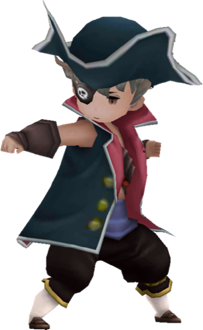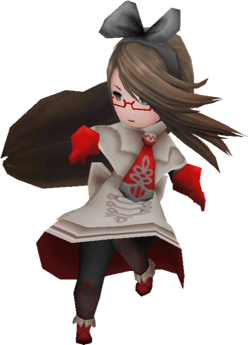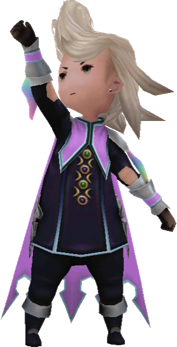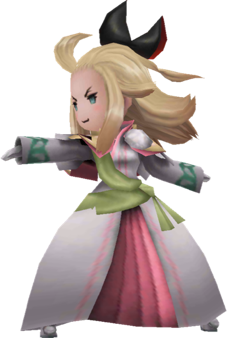Bravely Default has taken me a long time to get through. Not only is it the longest RPG I have ever played on the 3DS—I did the vast majority of the sidequests and ended up clocking just over 140 hours—but I took more than a few breaks from it as I played, some of which lasted a week or longer. However, this past Thursday, I finally beat the last boss and saw the credits roll. It was one a hell of a journey, to say the least, with some intriguing twists on old formulae and a problematic ending. Here’s how it all went.
The setting is Luxendarc, a world like one might find in many other JRPGs, and Final Fantasies in particular (it’s worth noting here that Square Enix is the publisher, and much of the team previously worked on Final Fantasy: The 4 Heroes of Light and the DS remakes of FFIII and FFIV). There are four elemental crystals whose health is maintained by priestesses called Vestals. When the village of Norende is instantly destroyed one day, the sole survivor, a shepherd named Tiz, teams up with Agnès, the Vestal of Wind, and her cryst-fairy companion Airy in order to set things right and possibly bring his town back. Their team soon expands by two more members: Ringabel, an amnesiac with a mysterious journal that seems to tell of future events, and Edea, who sees injustice in the actions of her father, the anti-Crystalist leader of the Duchy of Eternia. With Airy and “D’s Journal” as their guides, the ordinary boy, devout priestess, mysterious stranger, and rebellious princess traverse the world, awakening the crystals and fighting Eternia’s forces along the way.
 These forces are the primary source of “asterisks”, items which bestow new jobs to the party. Yes, in addition to the four crystals, another trait Bravely Default has inherited from the Final Fantasy series is the Job System. As it turns out, this game’s take on it is one of the best and most well-balanced ever conceived. Including the basic Freelancer, there are 24 jobs total, and although some are less useful than others, not a single one feels truly superfluous. Part of this is helped along by the fact that, in addition to the option of having a secondary set of unlocked job-specific skills equipped on a character (much like in FFV), there are many passive abilities that can be slotted in. These include basic attack and defense buffs, weapon affinities, status effect immunities, and automated actions like counterattacking. This dense variety of customization options can accommodate just about any sort of play style one can imagine.
These forces are the primary source of “asterisks”, items which bestow new jobs to the party. Yes, in addition to the four crystals, another trait Bravely Default has inherited from the Final Fantasy series is the Job System. As it turns out, this game’s take on it is one of the best and most well-balanced ever conceived. Including the basic Freelancer, there are 24 jobs total, and although some are less useful than others, not a single one feels truly superfluous. Part of this is helped along by the fact that, in addition to the option of having a secondary set of unlocked job-specific skills equipped on a character (much like in FFV), there are many passive abilities that can be slotted in. These include basic attack and defense buffs, weapon affinities, status effect immunities, and automated actions like counterattacking. This dense variety of customization options can accommodate just about any sort of play style one can imagine.
The battle system itself has a fair amount of flexibility. Bravely Default is a traditional turn-based affair, one in which all the party members’ commands for a single turn are dictated at once, then played out, Dragon Quest-style. Everything about the battles is quick and snappy—even summoning sequences are reasonably short—and later on, regular lower-level enemies can be dispatched instantly with a certain passive skill. As for the bosses, they are a decent enough challenge on normal difficulty and require a bit more strategizing than the random enemies, especially later on. At the heart of all this is the “Brave” and “Default” system. The former adds turns for any given character, and the latter stores them up. This system is useful both for stacking standard attacks and spells, as well as job-specific abilities which require multiple turns. On top of all this, there are special limit break-style attacks which are dependent on various factors, plus two additional options I completely ignored: summoned “friend” abilities and the time-freezing “Bravely Second”. If anything, this game proves that there is still room to innovate in the turn-based JRPG space, and does so with aplomb.
Those two unused battle options I mentioned above are reliant on DS hardware-specific features: friend lists and sleep mode. A third uses StreetPass to repopulate and speed the rebuilding of Norende in an ongoing minigame. Although this town-building mode adds both regular and exclusive items to special stores run by the wandering adventurers who serve as save points, this is another feature which can be safely ignored without greatly affecting the meat of the game.
Outside of battles, the task of getting around from place to place is fairly painless. There are at least two areas which have a lot of ground to cover between save points, plus there’s no quick and easy way to fully heal at said points (for example, the “tent” item present in many Final Fantasies), but otherwise, things are manageable. The dungeon layouts are simple enough to navigate, thanks in large part to automapping, as are the towns and other story-specific areas.
 Speaking of the game’s non-dungeon locations, they are absolutely gorgeous, with a hand-crafted look reminiscent of illustrations from fantasy books; the intricately detailed towns of Caldisla and Ancheim are two notable highlights. The overall color scheme of the game is suitably modest, even in colorful places like Florem. This palette helps bright flashy effects, when they appear during certain events, really pop. Likewise, the character art, music, sound effects, and voice acting only stand out in the sense that they’re high quality, and blend in nicely with the overall feel of the game. The localization is generally outstanding, although I do believe that the (understandable) changes made to the “Bravo Bikini” outfit could’ve been better handled, mainly by tailoring certain bits of dialogue to make it sound less scandalous than it ended up being.
Speaking of the game’s non-dungeon locations, they are absolutely gorgeous, with a hand-crafted look reminiscent of illustrations from fantasy books; the intricately detailed towns of Caldisla and Ancheim are two notable highlights. The overall color scheme of the game is suitably modest, even in colorful places like Florem. This palette helps bright flashy effects, when they appear during certain events, really pop. Likewise, the character art, music, sound effects, and voice acting only stand out in the sense that they’re high quality, and blend in nicely with the overall feel of the game. The localization is generally outstanding, although I do believe that the (understandable) changes made to the “Bravo Bikini” outfit could’ve been better handled, mainly by tailoring certain bits of dialogue to make it sound less scandalous than it ended up being.
Then there’s the deceptively minor features which enhance the whole experience. Chief amongst these is the Event Viewer, which allows the player to rewatch most any previously viewed scene. Neatly organized and easy to use, I relied heavily on the Event Viewer to get up to speed after most all of my longer breaks between play sessions. Another handy feature is Airy’s appearance on the bottom screen in the main and save menus, reminding you of where you are in the story and hinting at what mandatory event you should be doing next. There’s several other such niceties, including a handful of language options and an autosave feature that can be toggled at one’s leisure.
You may have noticed that so far, I have avoided discussing the finer details of the story. Unfortunately, I can’t properly do so without spoiling the first truly major plot twist, as well as events toward the end. The spoiler-free version is that Bravely Default‘s story takes a turn which is highly unusual for a JRPG, and one that has done it no favors in the eyes of many players. The ending also adds a couple of new plot details that, while cute, are unnecessary and/or contradict what has come before it. In short, Bravely Default is much like Valkyria Chronicles in its marriage of a damn near perfect aesthetic and play experience with a flawed story.
For the spoilery version, read on. MAJOR SPOILERS for the entirety of Bravely Default follow…
It should go without saying, but Ringabel’s buried memories are a key part of the game’s plot. Before they become a major focus of the story, however, the others have their time in the limelight. Agnès struggles with being one of the last Vestals, as well as one of the few remaining devotees of Crystalism in a rapidly changing world. Edea has turned her back on her family, friends, teachers, and beliefs in order to assist Agnès, and her wrestling with evolving ideas of right and wrong helps flesh out the connections between the party and their antagonists. Tiz, left with nothing and desperate to restore his hometown, has a particularly intense experience in Eisenberg, a war-torn land where he encounters a young orphan who reminds him of the kid brother he’d failed to save. All four party members have incredible chemistry, helped along by optional “Party Chats”, flavor text-filled conversations which are much like the “skits” found in Tales games.
The party’s interactions with the Eternian forces and other non-player characters vary a bit more, ranging from nuanced to archetypal. Certain antagonists that lean more toward the latter category stretch believability a bit, either in their outright villany (Profiteur, DeRosa) or for other reasons (the petulant Victoria being on the Council of Six). Fortunately, the most important NPCs also tend to be the most believable.
 Now, on to Ringabel’s place in the story. This starts at the end of Chapter Four, after all of the crystals have been awakened and the party enters the Pillar of Light that has appeared in the southeast. The first stirrings within his memory occur when the dark knight Alternis Dim attacks their airship and the party defeats him. Alternis’ helmet comes off, revealing a face that is identical to Ringabel’s. The knight also drops a suspiciously familiar-looking journal.
Now, on to Ringabel’s place in the story. This starts at the end of Chapter Four, after all of the crystals have been awakened and the party enters the Pillar of Light that has appeared in the southeast. The first stirrings within his memory occur when the dark knight Alternis Dim attacks their airship and the party defeats him. Alternis’ helmet comes off, revealing a face that is identical to Ringabel’s. The knight also drops a suspiciously familiar-looking journal.
Then, Chapter Five begins.
After Alternis’ defeat and Airy’s completion of her ritual, the party wakes up back in the starting kingdom of Caldisla. The Great Chasm that had swallowed Norende has not been sealed and, even worse, the crystals have returned to their former state of neglect. The party decides that they should try to awaken them again.
In Chapter Six, the same thing happens. Meanwhile, Ringabel is starting to remember a few details from his past. By the time Chapter Seven rolls around—at the start of which, everything has been reset again—Ringabel’s memory has been completely restored. He believes the party is traveling through parallel worlds, that he was the Alternis Dim from the world before the one that the rest of the party hails from, and that the evil mastermind behind all of this linking of alternate Luxendarcs is Airy. He tells Tiz, who later relays some of this information to Agnès with the help of Sage Yulyana. Along with Count DeRosso, Yulyana is an 1800+ year old man who was given a warning about a future cataclysm by an “angel” who was likely an Agnès from one of the previous worlds.
This all might seem confusing, but is actually straightforwardly presented throughout the story. In some ways, it’s too well-presented: for instance, the first information we get about the angel, and also Airy possibly being evil, is from a difficult optional quest at DeRosso’s castle, which is first accessible in Chapter Four. There are also a few spots where cracks start to show, such as with the tale of Agnès’ pendant and how odd it is that Edea seemingly had not recognized Rignabel/Alternis before, even though she grew up with him.
The parallel worlds themselves vary little, except in that Tiz, Agnès, and Edea are apparently either dead or missing in each one, and there are also some notable plot developments which mainly involve Ringabel and/or Yulyana. The asterisk-holding bosses from Chapters 1-4 can be fought again in optional sidequests, but until Chapter Seven, these battles don’t differ much from their predecessors and few add anything new to the story (they are, however, a great way to grind for Job Points and steal some high-grade items from, if little else). Likewise, the boss monsters in the crystals’ chambers must all be fought again, and aside from some upped stats, are more or less the same as before. This pads out an already lengthy game to an excessive degree with asset recycling that is unheard of, even when compared to certain Capcom games. While I understand the narrative necessity of the recycling, I believe Bravely Default‘s story could’ve been at least two chapters shorter without losing too much of its impact.
 After Chapter Eight and the fifth and final round of awakening the crystals, the final act begins. Airy reveals her true nature and a two-stage battle ensues. This time, there is only one sidequest—a ten-level dungeon with one save point at the entrance and no shortcuts—and oddly, the world map can still be explored. Another new dungeon has opened up above the Great Chasm, and it is in this where Ouroboros lies. Oh yes, there’s also a bunch of info-dumping in this ending section, including the identity of Airy’s master (Ouroboros); that there’s a home of the gods called the Celestial Realm; and the really bizarre, out-of-nowhere detail that Tiz is actually a vessel for one of these Celestials. Going by the opening and closing AR sequences, one can infer that the identity of this Celestial is the player.
After Chapter Eight and the fifth and final round of awakening the crystals, the final act begins. Airy reveals her true nature and a two-stage battle ensues. This time, there is only one sidequest—a ten-level dungeon with one save point at the entrance and no shortcuts—and oddly, the world map can still be explored. Another new dungeon has opened up above the Great Chasm, and it is in this where Ouroboros lies. Oh yes, there’s also a bunch of info-dumping in this ending section, including the identity of Airy’s master (Ouroboros); that there’s a home of the gods called the Celestial Realm; and the really bizarre, out-of-nowhere detail that Tiz is actually a vessel for one of these Celestials. Going by the opening and closing AR sequences, one can infer that the identity of this Celestial is the player.
After a dungeon crawl and a final fight against Airy, there’s an overlong battle against Ouroboros, which is punctuated by scripted events, including the arrival of alternate versions of the party to lend assistance. These parties are supposed to be summoned friends from previously linked parallel worlds (the game fills these slots in with AI friends if you don’t have any real ones registered), but similar to a certain event in Steins;Gate‘s final chapter, this is an endgame occurrence that doesn’t make any sense. According to the game’s story, Airy was supposed to have defeated all previous versions of the party, and not all of these parties included Ringabel/Alternis. How they are able to be there and support your crew during the final battle is never satisfactorily explained. This incongruent final act takes what once seemed like a potentially transcendent and shrewd story—at one point, I had a theory that Bravely Default was a commentary on the types of gamers who play the same old JRPGs over and over again—and swiftly turns it into the type of conventional and self-contradictory story we’ve seen before.
Despite some memorable and thought-provoking moments, there are a smattering of other problems with the story late in the game. For instance, at least one seemingly important thing is mentioned once (the “Grand Ritual”) but never followed up on. The term “Warriors of Light”—another inherited element from the Final Fantasy series, along with the crystals, job system, and many item names—is bandied about a bit in the later chapters, but not once fleshed out with any context. (It could be that the Grand Ritual, Warriors of Light, and other such loose ends are further discussed in the reams of supplemental text present in the game, in the form of D’s Journal and other documents, but they are never sufficiently explained within the core story itself.) There is an alternate ending which involves destroying the crystals, but the one time I tried shattering one, I gave up after a long stretch of fruitlessly mashing the X button (upon reflection, there may have been certain conditions that had to have been set first, but in that case, why should I have been able to try it to begin with?). Meanwhile, during the “true” ending, all of the party members return to their former worlds, but Ringabel is the only one who seems to have been sent back in time as well, with no indication given as to how this was possible. Tiz, on the other hand, simply disappears from Caldisla, being a Celestial and all.
You might’ve noticed my mention of Steins;Gate earlier. Upon seeing in the credits that someone from MAGES., the umbrella group that includes developer 5pb., was responsible for Bravely Default‘s scenario, I looked up some more information. It turns out that the scenario writer is Naotaka Hayashi, who also wrote Steins;Gate. So it appears that he likes alternate world/timeline stories, but does a poor job at ending them. Please remind me to avoid this scenario writer in the future whenever possible.
Fortunately, it seems that Bravely Second, the sequel teased at through a post-credits AR sequence, does not share its predecessor’s writer, and from what I’ve heard, has also toned down some of the more socially-dependant aspects of the various systems. I liked Bravely Default well enough to give its sequel a chance, largely because of its excellent aesthetics and systems, but after the long, long time I’ve spent with the former, I don’t plan on picking up Bravely Second for awhile yet.